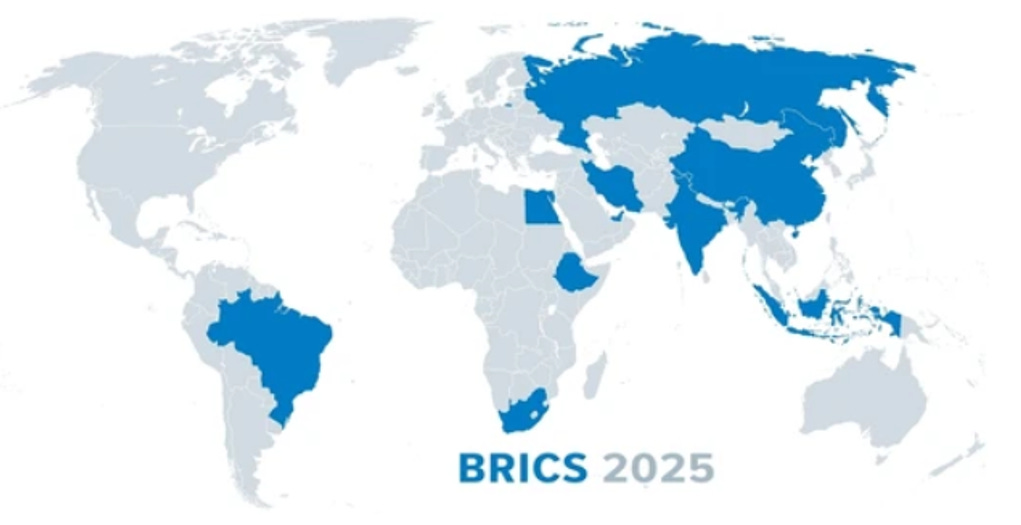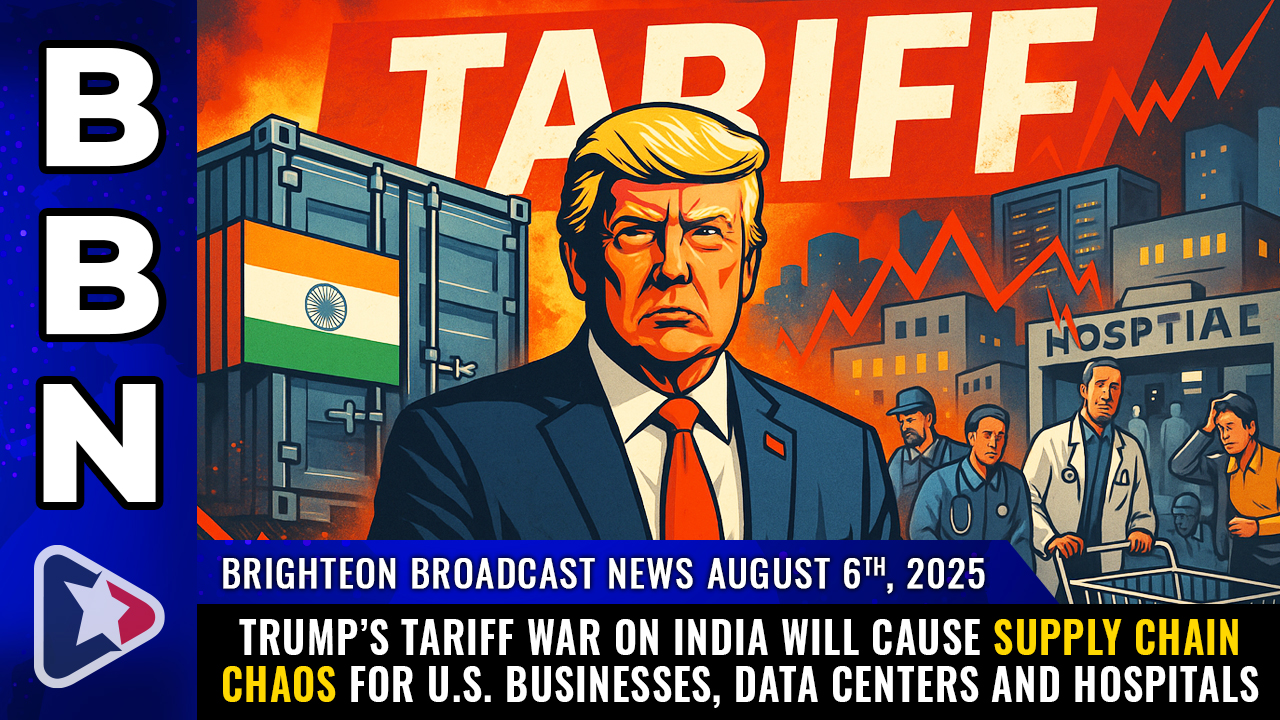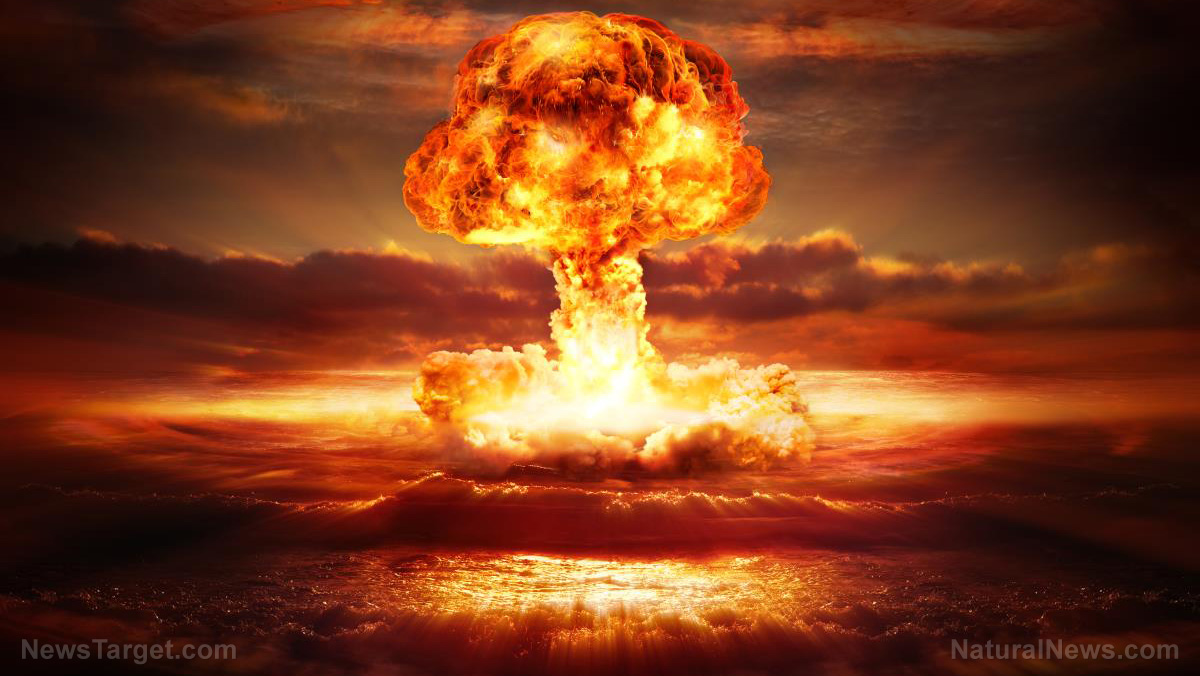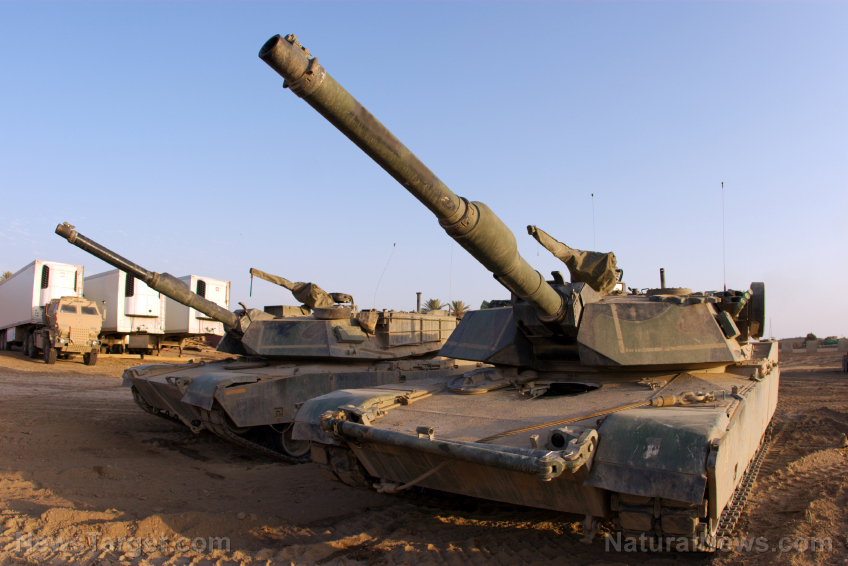 Parler
Parler Gab
Gab
 BRICS IS A STRATEGIC RESPONSE TO WESTERN SYSTEMIC DISINTEGRATION. South Africa is a founder member of BRICS which is now expanding and represents almost 50% of the global populace. The rising Global South must eventually be recognised as a complementary group of nations ready to join the global family. BUT this requires the Western powers (led by the USA) to forego their habit of claiming the leadership of the world, often by force, and it is documented history that those in power rarely give up without a fight.
“JOHANNESBURG – President Cyril Ramaphosa said the United States’s decision to impose significant tariffs on South African imports highlights the urgent need to diversify its trading partners. US President Donald Trump has implemented import taxes on several nations, slapping South Africa with a 30% tariff. This has raised concerns about the substantial costs associated with continuing trade with the US. Ramaphosa expressed the importance of South Africa to improve trade with African countries: “The recent announcements on tariffs by the United States, further underscore the need to diversify our export base and accelerate domestic value creation.”
Thus does Warwick Powell clarify the policies behind Trump’s latest bullying tactics, especially affecting South Africa. [Edited extracts from an excellent article by Warwick Powell]
“Any Country aligning themselves with the Anti-American policies of BRICS, will be charged an ADDITIONAL 10% Tariff. There will be no exceptions to this policy. Thank you for your attention to this matter!”, bellowed U.S. President Donal Trump on July 7, 2025. This social media outburst was prompted by the issuance of a joint statement by BRICS leaders, who convened in Rio de Janeiro in Brazil.
Trump then began signing and sending off his fabled tariff letters, announcing to recipient heads of state the unilateral determination of Trump’s administration on the applicable tariff to be charged for products from the BRICS countries. The letters opined about the absence of reciprocity, rationalising whatever tariff rate Trump announced.
These two missives seem intertwined, reflective of failed bilateral ‘negotiations’ after the suspension of the ‘Liberation Day’ tariffs on the one hand, and a belief that BRICS is an American adversary on the other. The failure of negotiations over almost 90 days suggests a collapse of American leverage and the pretence of an indifference threshold amongst many nations. Trump’s suspension two days after the grand proclamation of the ‘reciprocal’ tariffs regime on most countries, and the subsequent escalation of tariffs with China, which refused to cede to unilateral whims, evoked a strategic blunder of considerable proportions.
Trump has boxed himself into a corner. No matter how many puckered lips he would claim were lining up to “kiss my ass”, the Trump administration had effectively alienated nations across the board while creating strong incentives for them to coordinate their approaches.
And the convening of BRICS in Brazil, marks more than just another gathering of non-Western states. It has become a declaration, quiet but unmistakable, that a new global architecture is being formed. Despite years of Western scepticism and efforts at containment, BRICS has expanded its institutional footprint, global relevance, and strategic coherence.
Now, with ten full members, an expanding circle of partner countries, and over 50 countries seeking affiliation, BRICS is no longer merely a diplomatic forum. It is becoming a gravitational force within the emerging multipolar world, and a structural response to the intensifying contradictions of Western-led globalisation.
The BRICS network accounts for around 50% of global GDP on a purchasing power parity (PPP) basis. It represents more than half the world’s population. BRICS nations are delivering stronger growth than the collective west. More critically, it commands a vast share of the world’s energy reserves, industrial production, and critical minerals thereby placing it at the centre of the real economy upon which global stability depends.
This influence is not only economic but is systemic. In a world where the material foundations of prosperity are under threat where energy, infrastructure, and food systems are the BRICS model for international cooperation rooted in mutual development, strategic autonomy, and infrastructural interdependence; sovereign and interdependent.
The Real Economy and Systemic Exchange Value are unlike the financialised West, BRICS economies remain grounded in the logic of is termed ‘Systemic Exchange Value’ which is the capacity to generate and circulate real-use values necessary for social reproduction and economic sustainability. Energy is not only a commodity to be speculated, it is the substrate of productive life: the energetic base upon which value is created, stored and exchanged.
The BRICS grouping owns decisive structural advantages. Russia, Iran, Brazil, the UAE and Saudi Arabia are major energy producers. China leads in renewable energy capacity, grid innovation, and energy storage. These endowments allow BRICS members to anchor value in material production, rather than financialisation.
This contrasts sharply with the West, particularly the United States, where value extraction has become divorced from real production. What began in the 1970s as the liberalisation of capital markets has matured into a regime of financialisation, where profitability is driven less by technological innovation or productivity growth, and more by asset inflation, debt-leveraged speculation, and shareholder enrichment.
The US Financial Model creates global distortions and domestic paucity. The transformation of the US economy over the last four decades has been profound, and destabilising. Capital has moved into financial assets rather than physical infrastructure. Corporations increasingly prioritise share buybacks over investment in fixed capital formation. Banks have shifted from lending to productive enterprises to acting as speculative platforms. The result is a bifurcated economy: financial wealth accumulation at the top and stagnation and precarity for the 90%.
Domestically, this has produced extreme inequality, shrinking industrial employment and a decaying infrastructure base. Real wages have stagnated for the majority, household debt has soared, and a generation of Americans face declining life expectancy, unaffordable healthcare, housing, and education. Politically, this has fueled polarisation, disenchantment and a retreat into nostalgia and culture war posturing.
Globally, the consequences are likewise corrosive. The dollar’s status as the world’s reserve currency has allowed the US to externalise its imbalances by running persistent trade deficits while exporting volatility. Nations are forced to hold dollar reserves to access global markets, tying their monetary policies to the Federal Reserve and exposing them to cycles of capital flight, interest rate shocks, and dollar liquidity shortages.
The United States depends on financial inflows to fund consumption, while the real economy withers. In parallel, it has deployed financial infrastructure: SWIFT, sanctions, and dollar clearing as a geopolitical weapon. The more these tools are used for coercion, the greater the incentive for the rest of the world to work around them. What was once a privilege is now a liability. The logic of systemic dysfunction is not limited to the United States.
Europe’s economic travails in Energy, Competitiveness, and Strategic Confusion have caused Western Europe to face a different but none-the-less severe crises. Europe’s postwar model, anchored in German industrial might, French agricultural stability, and cheap energy imports (primarily from Russia), has been dismantled by geopolitical issues and self-inflicted policy incoherence.
The decision to sever Russian energy supplies has plunged Europe into a state of structural energy insecurity. Natural gas prices have surged. Electricity costs are among the highest in the world. Manufacturing is being offshored or shuttered altogether. German industry, the continent’s manufacturing backbone, now faces an existential crisis. Steel, chemicals, and automotive sectors which were once global leaders are struggling to survive.
At the same time, Europe’s ‘green’ transition has stalled. Over-reliance on intermittent renewables, premature decommissioning of nuclear and fossil infrastructure, and failure to invest in storage or grid resilience have created a perfect storm of vulnerability. What began as an energy transition has become an energy trap.
Europe’s response of subsidies, tariffs and strategic autonomy slogans, amounts to reactive protectionism. Meanwhile, Europe’s geopolitical positioning grows more incoherent. It champions multilateralism while participating in sanctions that fragment trade. It lectures on rules while seizing sovereign assets. It preaches peace while escalating military deployments.
This crisis is not merely cyclical; rather, it is structural. Europe no longer possesses a coherent industrial or energy strategy. It has outsourced security to the US, supply chains to Asia, and now is in a strategic cul-de-sac, dependent on expensive American LNG, locked into US-led confrontation with China, and unable to generate sufficient economic growth.
Europe’s excessive military spending might inject temporary new liquidity into a failing economic system, but it will also channel funds into a narrow range of activities with limited system-wide benefit. The rentiers of the military industrial complex will, doubtless be gleeful in anticipation but ordinary working households will find little joy in this militarised strategy.
In this context, the attacks on BRICS members being economic, rhetorical and sometimes military must be seen for what they are: reactive. Unable to resolve their own internal contradictions, Western powers have projected blame outward, targeting those who dare to pursue alternative development paths. Russia is sanctioned not merely for military actions, but for asserting resource sovereignty. Iran is isolated and attacked, not for its nuclear ambitions, but for refusing to bow to Western economic dictates. China is confronted, not because it poses an ideological threat, but because it models a functioning alternative: one based on infrastructure, planning and state-led development. Even neutral states seeking to hedge: India, Brazil and South Africa are treated with suspicion and pressure. What these reactions reflect is a deeper insecurity.
The Western rules-based order, rooted in postwar liberalism, post-Cold War unipolarity, and ‘Full Spectrum Dominance’ is no longer able to secure domestic cohesion or global legitimacy. Its crises, of inflation, inequality, ecological volatility and institutional breakdown, are internal. Yet its response is externalisation: punish others, fragment the world and escalate tensions.
Ironically, these efforts only accelerate the very transformations they seek to delay. Sanctions create incentives for monetary innovation. Exclusion drives new institutional forms. Hostility produces solidarity. The attempt to smother BRICS has, in effect, given it purpose.
BRICS has created a Strategic Infrastructure for a New Developmental World. In this landscape, BRICS offers the Global South two essential strategies. First, it provides a platform for reform. Many BRICS members continue to call for the transformation, not the abandonment, of existing multilateral institutions. This includes fairer voting rights in the IMF and World Bank, a restructured UN Security Council and global trade rules that support industrial development, not just liberalisation. This focus on reforming existing institutions was again prominent in the joint statement of BRICS nations.
Second, it offers protection. Should reform prove impossible, BRICS is building systems to reduce dependence: trade in national currencies, sovereign digital platforms, development banks without conditionality, and cooperative approaches to energy, food and technology. The goal is resilience not autarky, but autonomy with interdependence. Again, this hedging could be seen in the progressive development and consolidation of its own institutions that run in parallel to, and not against, those Western dominant institutions created in the post-war era.
This shift is already visible. The BRICS New Development Bank funds projects in local currencies. Russia and China conduct energy trade outside of the dollar. Saudi Arabia and the UAE are engaging in multipolar financial and energy diplomacy. Even African and Latin American states are exploring BRICS+ engagements to break free from debt cycles and dependency. The introduction of Indonesia and other countries of southeast Asia into the grouping simply consolidates the diversity of economic resources that can contribute to more effective and balanced trading amongst member states.
China is the Unflappable Heart of the Multipolar Order. At the heart of BRICS lies China, a disciplined and innovative society. Its rise is not only a function of scale, but of strategic continuity based on long-term thinking. In contrast to the volatility of Western politics, China offers stability. It invests in long-term infrastructure, pursues ecological modernisation, and promotes interconnectivity through logistics, finance and data platforms.
China does not demand ideological conformity within BRICS or indeed elsewhere across the Belt and Road Initiative ecosystem. Instead, it enables alignment on shared goals: development, energy security, technological upgrades and multipolar cooperation. It embodies not a hegemonic power, but a gravitational one, capable of holding diverse partners together while avoiding collapse into rivalry. The watchword is: “Promotion by Attraction”
The age of Western-dominated globalisation is coming to an end. What remains is a transition marked by some uncertainty and flux; one defined by systemic instability, geopolitical realignment and the search for new institutional forms. BRICS is not an anti-Western project. It is a post-Western one. It represents a collective effort to recover sovereignty, build real economies, and reconfigure global governance in line with contemporary realities. It offers the developing world tools of cooperation and mutual empowerment, rather than economic dependency and endless wars, the hallmark of Western dominance for 80 years.
For the West, BRICS is a major challenge to the American Empire. It likely will be met with hostility and hubris (the current default reaction) or perhaps introspection and reform will prevail. However the choice is narrowing because the world will not wait for the West to change its colours. BRICS is not the future because it seeks to displace the West. BRICS is the future because it is already doing what the West no longer can: building systems that work, for the majority of humanity, in the real world of energy, infrastructure and interdependence. And South Africa is already wedded to the Global South strategy.
Read more at: TheBurningPlatform.com
BRICS IS A STRATEGIC RESPONSE TO WESTERN SYSTEMIC DISINTEGRATION. South Africa is a founder member of BRICS which is now expanding and represents almost 50% of the global populace. The rising Global South must eventually be recognised as a complementary group of nations ready to join the global family. BUT this requires the Western powers (led by the USA) to forego their habit of claiming the leadership of the world, often by force, and it is documented history that those in power rarely give up without a fight.
“JOHANNESBURG – President Cyril Ramaphosa said the United States’s decision to impose significant tariffs on South African imports highlights the urgent need to diversify its trading partners. US President Donald Trump has implemented import taxes on several nations, slapping South Africa with a 30% tariff. This has raised concerns about the substantial costs associated with continuing trade with the US. Ramaphosa expressed the importance of South Africa to improve trade with African countries: “The recent announcements on tariffs by the United States, further underscore the need to diversify our export base and accelerate domestic value creation.”
Thus does Warwick Powell clarify the policies behind Trump’s latest bullying tactics, especially affecting South Africa. [Edited extracts from an excellent article by Warwick Powell]
“Any Country aligning themselves with the Anti-American policies of BRICS, will be charged an ADDITIONAL 10% Tariff. There will be no exceptions to this policy. Thank you for your attention to this matter!”, bellowed U.S. President Donal Trump on July 7, 2025. This social media outburst was prompted by the issuance of a joint statement by BRICS leaders, who convened in Rio de Janeiro in Brazil.
Trump then began signing and sending off his fabled tariff letters, announcing to recipient heads of state the unilateral determination of Trump’s administration on the applicable tariff to be charged for products from the BRICS countries. The letters opined about the absence of reciprocity, rationalising whatever tariff rate Trump announced.
These two missives seem intertwined, reflective of failed bilateral ‘negotiations’ after the suspension of the ‘Liberation Day’ tariffs on the one hand, and a belief that BRICS is an American adversary on the other. The failure of negotiations over almost 90 days suggests a collapse of American leverage and the pretence of an indifference threshold amongst many nations. Trump’s suspension two days after the grand proclamation of the ‘reciprocal’ tariffs regime on most countries, and the subsequent escalation of tariffs with China, which refused to cede to unilateral whims, evoked a strategic blunder of considerable proportions.
Trump has boxed himself into a corner. No matter how many puckered lips he would claim were lining up to “kiss my ass”, the Trump administration had effectively alienated nations across the board while creating strong incentives for them to coordinate their approaches.
And the convening of BRICS in Brazil, marks more than just another gathering of non-Western states. It has become a declaration, quiet but unmistakable, that a new global architecture is being formed. Despite years of Western scepticism and efforts at containment, BRICS has expanded its institutional footprint, global relevance, and strategic coherence.
Now, with ten full members, an expanding circle of partner countries, and over 50 countries seeking affiliation, BRICS is no longer merely a diplomatic forum. It is becoming a gravitational force within the emerging multipolar world, and a structural response to the intensifying contradictions of Western-led globalisation.
The BRICS network accounts for around 50% of global GDP on a purchasing power parity (PPP) basis. It represents more than half the world’s population. BRICS nations are delivering stronger growth than the collective west. More critically, it commands a vast share of the world’s energy reserves, industrial production, and critical minerals thereby placing it at the centre of the real economy upon which global stability depends.
This influence is not only economic but is systemic. In a world where the material foundations of prosperity are under threat where energy, infrastructure, and food systems are the BRICS model for international cooperation rooted in mutual development, strategic autonomy, and infrastructural interdependence; sovereign and interdependent.
The Real Economy and Systemic Exchange Value are unlike the financialised West, BRICS economies remain grounded in the logic of is termed ‘Systemic Exchange Value’ which is the capacity to generate and circulate real-use values necessary for social reproduction and economic sustainability. Energy is not only a commodity to be speculated, it is the substrate of productive life: the energetic base upon which value is created, stored and exchanged.
The BRICS grouping owns decisive structural advantages. Russia, Iran, Brazil, the UAE and Saudi Arabia are major energy producers. China leads in renewable energy capacity, grid innovation, and energy storage. These endowments allow BRICS members to anchor value in material production, rather than financialisation.
This contrasts sharply with the West, particularly the United States, where value extraction has become divorced from real production. What began in the 1970s as the liberalisation of capital markets has matured into a regime of financialisation, where profitability is driven less by technological innovation or productivity growth, and more by asset inflation, debt-leveraged speculation, and shareholder enrichment.
The US Financial Model creates global distortions and domestic paucity. The transformation of the US economy over the last four decades has been profound, and destabilising. Capital has moved into financial assets rather than physical infrastructure. Corporations increasingly prioritise share buybacks over investment in fixed capital formation. Banks have shifted from lending to productive enterprises to acting as speculative platforms. The result is a bifurcated economy: financial wealth accumulation at the top and stagnation and precarity for the 90%.
Domestically, this has produced extreme inequality, shrinking industrial employment and a decaying infrastructure base. Real wages have stagnated for the majority, household debt has soared, and a generation of Americans face declining life expectancy, unaffordable healthcare, housing, and education. Politically, this has fueled polarisation, disenchantment and a retreat into nostalgia and culture war posturing.
Globally, the consequences are likewise corrosive. The dollar’s status as the world’s reserve currency has allowed the US to externalise its imbalances by running persistent trade deficits while exporting volatility. Nations are forced to hold dollar reserves to access global markets, tying their monetary policies to the Federal Reserve and exposing them to cycles of capital flight, interest rate shocks, and dollar liquidity shortages.
The United States depends on financial inflows to fund consumption, while the real economy withers. In parallel, it has deployed financial infrastructure: SWIFT, sanctions, and dollar clearing as a geopolitical weapon. The more these tools are used for coercion, the greater the incentive for the rest of the world to work around them. What was once a privilege is now a liability. The logic of systemic dysfunction is not limited to the United States.
Europe’s economic travails in Energy, Competitiveness, and Strategic Confusion have caused Western Europe to face a different but none-the-less severe crises. Europe’s postwar model, anchored in German industrial might, French agricultural stability, and cheap energy imports (primarily from Russia), has been dismantled by geopolitical issues and self-inflicted policy incoherence.
The decision to sever Russian energy supplies has plunged Europe into a state of structural energy insecurity. Natural gas prices have surged. Electricity costs are among the highest in the world. Manufacturing is being offshored or shuttered altogether. German industry, the continent’s manufacturing backbone, now faces an existential crisis. Steel, chemicals, and automotive sectors which were once global leaders are struggling to survive.
At the same time, Europe’s ‘green’ transition has stalled. Over-reliance on intermittent renewables, premature decommissioning of nuclear and fossil infrastructure, and failure to invest in storage or grid resilience have created a perfect storm of vulnerability. What began as an energy transition has become an energy trap.
Europe’s response of subsidies, tariffs and strategic autonomy slogans, amounts to reactive protectionism. Meanwhile, Europe’s geopolitical positioning grows more incoherent. It champions multilateralism while participating in sanctions that fragment trade. It lectures on rules while seizing sovereign assets. It preaches peace while escalating military deployments.
This crisis is not merely cyclical; rather, it is structural. Europe no longer possesses a coherent industrial or energy strategy. It has outsourced security to the US, supply chains to Asia, and now is in a strategic cul-de-sac, dependent on expensive American LNG, locked into US-led confrontation with China, and unable to generate sufficient economic growth.
Europe’s excessive military spending might inject temporary new liquidity into a failing economic system, but it will also channel funds into a narrow range of activities with limited system-wide benefit. The rentiers of the military industrial complex will, doubtless be gleeful in anticipation but ordinary working households will find little joy in this militarised strategy.
In this context, the attacks on BRICS members being economic, rhetorical and sometimes military must be seen for what they are: reactive. Unable to resolve their own internal contradictions, Western powers have projected blame outward, targeting those who dare to pursue alternative development paths. Russia is sanctioned not merely for military actions, but for asserting resource sovereignty. Iran is isolated and attacked, not for its nuclear ambitions, but for refusing to bow to Western economic dictates. China is confronted, not because it poses an ideological threat, but because it models a functioning alternative: one based on infrastructure, planning and state-led development. Even neutral states seeking to hedge: India, Brazil and South Africa are treated with suspicion and pressure. What these reactions reflect is a deeper insecurity.
The Western rules-based order, rooted in postwar liberalism, post-Cold War unipolarity, and ‘Full Spectrum Dominance’ is no longer able to secure domestic cohesion or global legitimacy. Its crises, of inflation, inequality, ecological volatility and institutional breakdown, are internal. Yet its response is externalisation: punish others, fragment the world and escalate tensions.
Ironically, these efforts only accelerate the very transformations they seek to delay. Sanctions create incentives for monetary innovation. Exclusion drives new institutional forms. Hostility produces solidarity. The attempt to smother BRICS has, in effect, given it purpose.
BRICS has created a Strategic Infrastructure for a New Developmental World. In this landscape, BRICS offers the Global South two essential strategies. First, it provides a platform for reform. Many BRICS members continue to call for the transformation, not the abandonment, of existing multilateral institutions. This includes fairer voting rights in the IMF and World Bank, a restructured UN Security Council and global trade rules that support industrial development, not just liberalisation. This focus on reforming existing institutions was again prominent in the joint statement of BRICS nations.
Second, it offers protection. Should reform prove impossible, BRICS is building systems to reduce dependence: trade in national currencies, sovereign digital platforms, development banks without conditionality, and cooperative approaches to energy, food and technology. The goal is resilience not autarky, but autonomy with interdependence. Again, this hedging could be seen in the progressive development and consolidation of its own institutions that run in parallel to, and not against, those Western dominant institutions created in the post-war era.
This shift is already visible. The BRICS New Development Bank funds projects in local currencies. Russia and China conduct energy trade outside of the dollar. Saudi Arabia and the UAE are engaging in multipolar financial and energy diplomacy. Even African and Latin American states are exploring BRICS+ engagements to break free from debt cycles and dependency. The introduction of Indonesia and other countries of southeast Asia into the grouping simply consolidates the diversity of economic resources that can contribute to more effective and balanced trading amongst member states.
China is the Unflappable Heart of the Multipolar Order. At the heart of BRICS lies China, a disciplined and innovative society. Its rise is not only a function of scale, but of strategic continuity based on long-term thinking. In contrast to the volatility of Western politics, China offers stability. It invests in long-term infrastructure, pursues ecological modernisation, and promotes interconnectivity through logistics, finance and data platforms.
China does not demand ideological conformity within BRICS or indeed elsewhere across the Belt and Road Initiative ecosystem. Instead, it enables alignment on shared goals: development, energy security, technological upgrades and multipolar cooperation. It embodies not a hegemonic power, but a gravitational one, capable of holding diverse partners together while avoiding collapse into rivalry. The watchword is: “Promotion by Attraction”
The age of Western-dominated globalisation is coming to an end. What remains is a transition marked by some uncertainty and flux; one defined by systemic instability, geopolitical realignment and the search for new institutional forms. BRICS is not an anti-Western project. It is a post-Western one. It represents a collective effort to recover sovereignty, build real economies, and reconfigure global governance in line with contemporary realities. It offers the developing world tools of cooperation and mutual empowerment, rather than economic dependency and endless wars, the hallmark of Western dominance for 80 years.
For the West, BRICS is a major challenge to the American Empire. It likely will be met with hostility and hubris (the current default reaction) or perhaps introspection and reform will prevail. However the choice is narrowing because the world will not wait for the West to change its colours. BRICS is not the future because it seeks to displace the West. BRICS is the future because it is already doing what the West no longer can: building systems that work, for the majority of humanity, in the real world of energy, infrastructure and interdependence. And South Africa is already wedded to the Global South strategy.
Read more at: TheBurningPlatform.com
New Jersey secures record $2 billion PFAS settlement with DuPont, Chemours and Corteva
By Laura Harris // Share
Trump threatens tariffs on India amid Russian oil purchases, risking global trade fight
By Finn Heartley // Share
FBI expands global reach with New Zealand office amid escalating surveillance concerns
By Finn Heartley // Share
Russia abandons INF Treaty restraints, threatens new arms race as U.S. allies deploy missiles
By Willow Tohi // Share
Governments continue to obscure COVID-19 vaccine data amid rising concerns over excess deaths
By patricklewis // Share
Tech giant Microsoft backs EXTINCTION with its support of carbon capture programs
By ramontomeydw // Share
Germany to resume arms exports to Israel despite repeated ceasefire violations
By isabelle // Share









